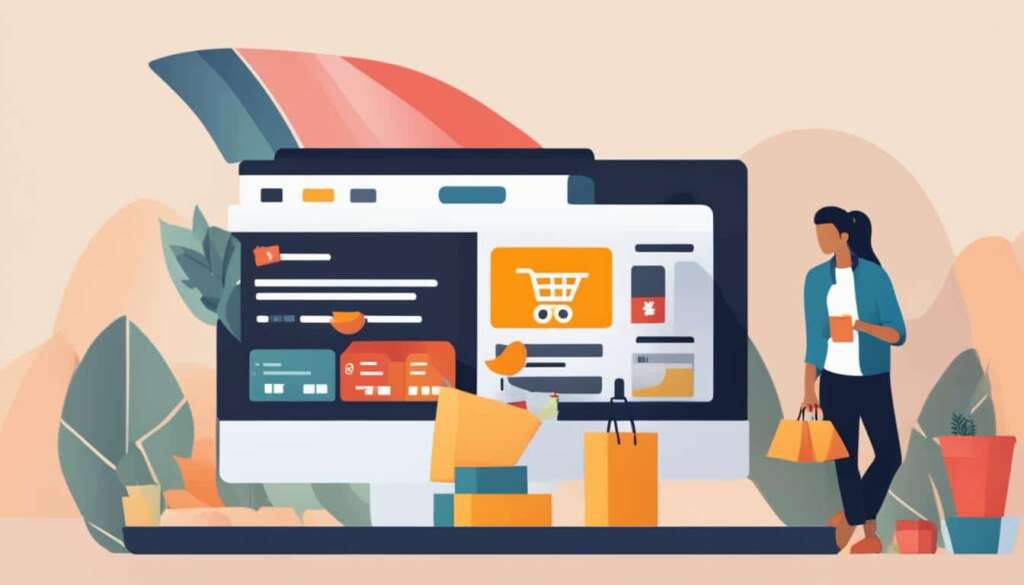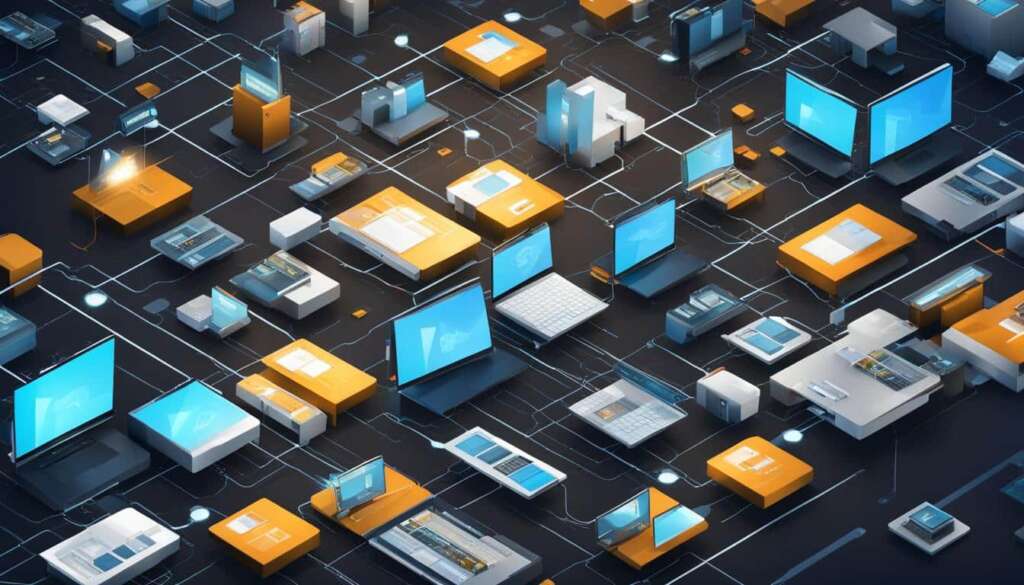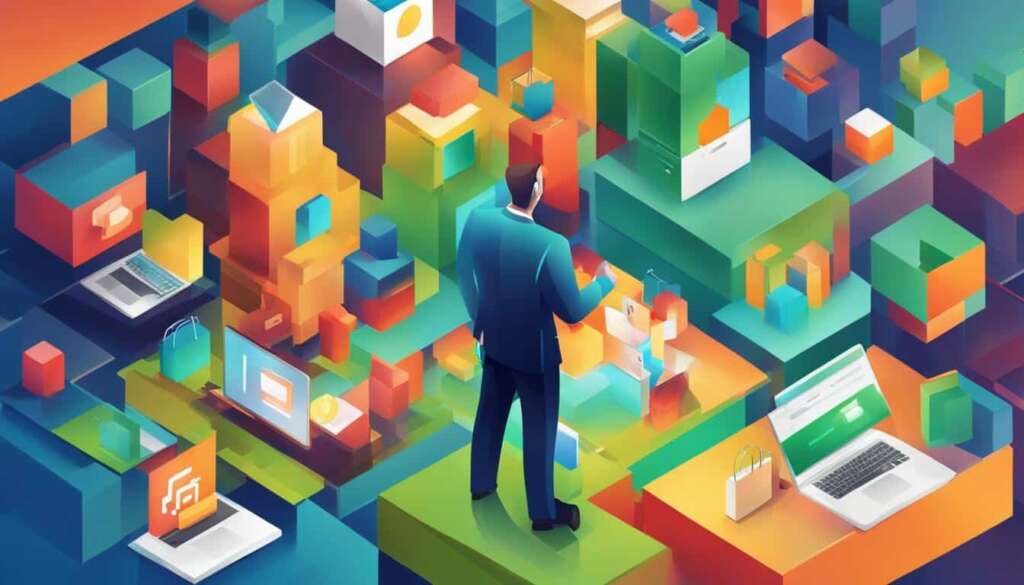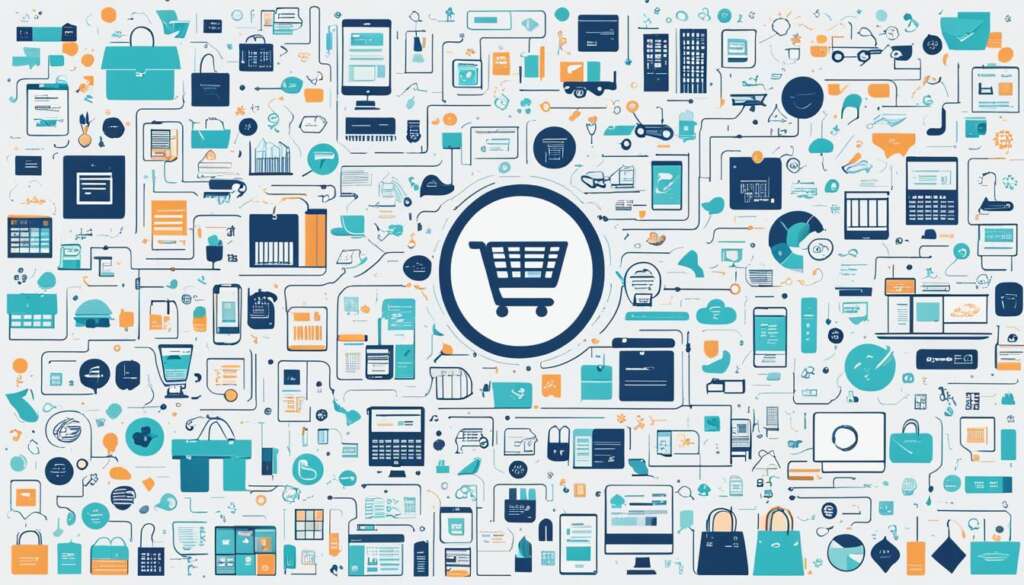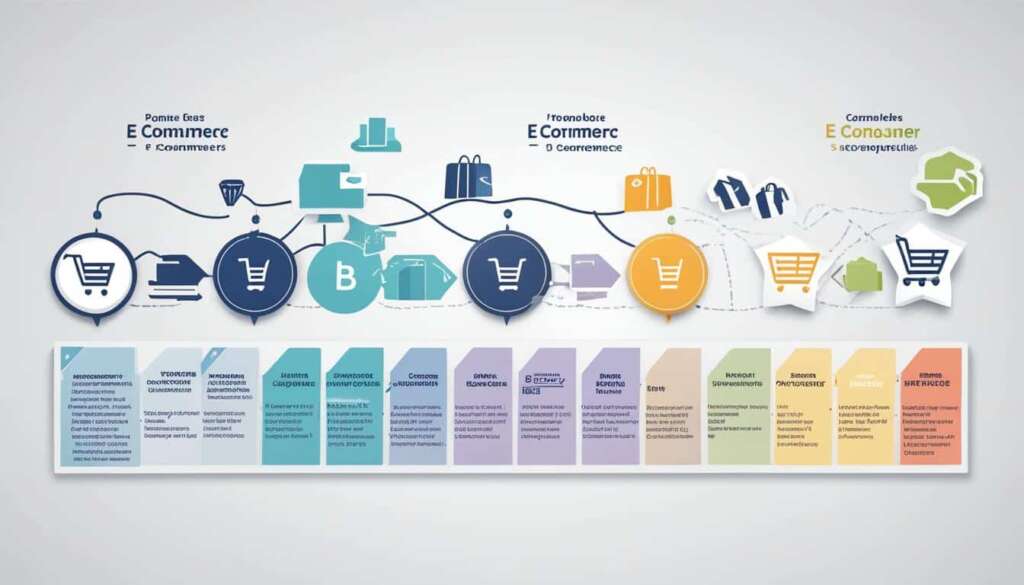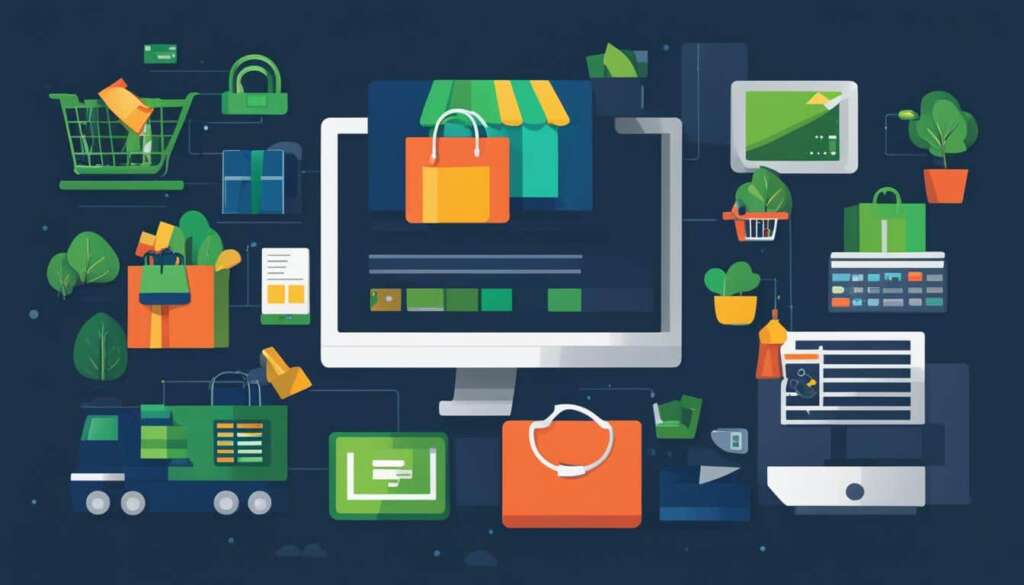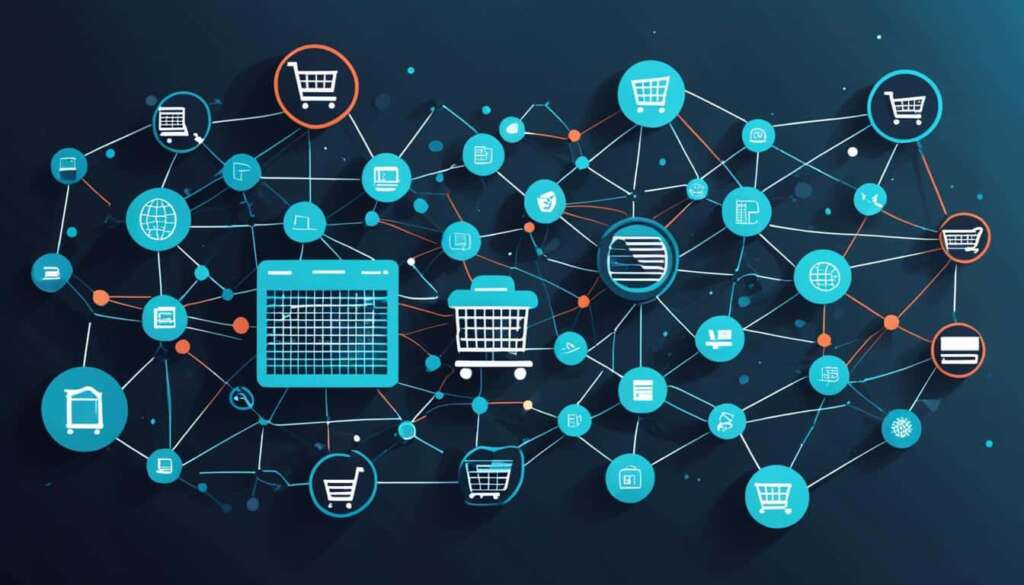Table of Contents
When starting an online business, one of the key factors to consider is the e-commerce business model. A business model determines whom you sell your products or services to and how you interact with your customers. By understanding the different online business models available, you can choose the most suitable approach for your venture.
There are several types of e-commerce business models to consider. These include Business-to-Consumer (B2C), Business-to-Business (B2B), Consumer-to-Consumer (C2C), Business-to-Government (B2G), Direct-to-Consumer (D2C), and Consumer-to-Business (C2B). Each model has its own unique characteristics, advantages, and target audience.
Having a clear understanding of these various online business models will enable you to make informed decisions about how you sell your products, reach customers, and manage your operations. In the following sections, we will delve into each model in more detail, exploring their features, benefits, and considerations.
Let’s explore the various e-commerce business models, starting with the popular Business-to-Consumer (B2C) model.
B2C Business Model
The B2C (Business-to-Consumer) business model is the most common type of e-commerce model that involves selling products or services directly to end users. In this model, businesses cater to the needs of individual consumers, offering a wide range of products and services through various channels, such as online marketplaces or dedicated retail websites.
With B2C e-commerce, businesses have the opportunity to tap into a large potential customer base, reaching consumers around the world. This model allows businesses to establish direct relationships with their customers, enabling personalized marketing and customer service experiences.
However, B2C businesses face their fair share of challenges. One common challenge is customer retention, as competition in the online marketplace is fierce. To stay ahead, businesses need to provide exceptional customer experiences, engage in targeted marketing strategies, and adapt to evolving consumer preferences.
“The B2C model is all about selling directly to the end users, meeting their needs, and building lasting relationships through personalized experiences.”
Overall, the B2C business model offers tremendous opportunities for businesses to thrive in the dynamic world of e-commerce. By understanding and meeting the demands of end users, businesses can establish themselves as trusted brands and drive growth in the competitive online market.
Advantages of the B2C Business Model
- Direct access to a broad customer base
- Potential for personalized marketing and customer experiences
- Opportunities for brand building and customer loyalty
Challenges of the B2C Business Model
- Fierce competition in the online marketplace
- Customer retention and loyalty
- Continuous adaptation to changing consumer preferences
| Advantages | Challenges |
|---|---|
| Direct access to a broad customer base | Fierce competition in the online marketplace |
| Potential for personalized marketing and customer experiences | Customer retention and loyalty |
| Opportunities for brand building and customer loyalty | Continuous adaptation to changing consumer preferences |
B2B Business Model
The B2B (business-to-business) e-commerce model involves one business selling products or services to another business. This type of transaction can include the sale of raw materials or the provision of specialized services tailored specifically for other businesses. B2B businesses often have repeat customers and enjoy the benefits of recurring revenue streams.
However, B2B e-commerce may present some unique challenges. Compared to B2C, B2B businesses typically have a smaller customer base, as their primary focus is on selling to other businesses rather than individual consumers. This narrower target market requires a tailored approach to marketing and sales strategies.
Furthermore, B2B negotiations often revolve around price, payment terms, and other contractual agreements. These negotiations can influence the profitability and success of B2B transactions. Building strong relationships with business customers and understanding their specific needs is crucial for turning negotiations into mutually beneficial partnerships.
B2B e-commerce is an essential component of the digital marketplace, facilitating seamless transactions between businesses and driving economic growth.
Advantages of the B2B Business Model
The B2B model offers several advantages for businesses looking to sell to other businesses:
- Repeat customers: B2B transactions often result in long-term partnerships and repeat sales, providing a reliable revenue stream for businesses.
- Recurring revenue: B2B sales often involve ongoing contracts or subscriptions, allowing businesses to enjoy a steady income.
- Higher order volume: B2B customers typically place larger orders compared to individual consumers, leading to higher average transaction values.
- Business-focused: B2B transactions focus on fulfilling the specific needs of businesses, allowing for targeted marketing and specialized products or services.
Challenges of the B2B Business Model
While the B2B business model has its advantages, it also comes with unique challenges:
- Smaller customer base: B2B businesses often target a niche market, resulting in a smaller customer base compared to B2C businesses.
- Complex negotiations: B2B transactions frequently involve negotiations on pricing, terms, and other contractual agreements, requiring skilled negotiation tactics.
- Intense competition: With a narrower target market, B2B businesses often face intense competition from other businesses offering similar products or services.
- Specialized marketing: B2B marketing strategies need to be tailored to the specific needs and preferences of business customers, focusing on industry expertise and value-added solutions.
The B2B business model has proven to be a successful strategy for companies selling to other businesses. By understanding the unique dynamics of B2B e-commerce and effectively navigating the challenges, businesses can capitalize on opportunities and forge valuable partnerships in the B2B marketplace.
| Advantages | Challenges |
|---|---|
| Repeat customers | Smaller customer base |
| Recurring revenue | Complex negotiations |
| Higher order volume | Intense competition |
| Business-focused | Specialized marketing |
C2C and B2B2C Business Models
In the world of e-commerce, there are various business models that cater to different customer segments and needs. Two such models are C2C (consumer-to-consumer) and B2B2C (business-to-business-to-consumer). Let’s explore these models and understand how they function.
C2C E-commerce
C2C e-commerce refers to the practice of individuals selling products or services directly to other consumers. This model is typically facilitated through online marketplaces where individuals can create listings and engage in transactions with other users.
With C2C e-commerce, anyone can become a seller and leverage the power of online platforms to reach a wide audience. It allows individuals to monetize their unused or unwanted items while providing others with access to a variety of products.
C2C e-commerce platforms provide a convenient and secure environment for buyers and sellers to connect, negotiate prices, and complete transactions. Examples of popular C2C platforms include eBay, Etsy, and Craigslist.
B2B2C E-commerce
B2B2C e-commerce, on the other hand, involves a business selling its products or services through another organization to end consumers. This model relies on intermediary platforms that connect businesses and consumers, creating a seamless buying experience.
By partnering with an intermediary platform, businesses can expand their reach and tap into a new customer base. This model allows businesses to leverage the existing customer trust and loyalty of the intermediary, which can result in increased sales and brand exposure.
An example of B2B2C e-commerce is when a manufacturer sells its products through an online retailer. The retailer acts as the intermediary, handling the sales process and delivering the products to the end consumers.
It’s important for businesses considering the B2B2C model to carefully choose their intermediaries, as the success of the partnership relies on the platform’s reputation, customer base, and marketing capabilities.
Both C2C and B2B2C e-commerce models have their unique benefits and challenges. While C2C allows individuals to monetize their belongings and connect directly with consumers, B2B2C provides businesses with an opportunity to reach a wider customer base through trusted intermediaries.

Other E-Commerce Business Models
While the B2C and B2B business models dominate the e-commerce landscape, there are other models that provide unique opportunities and challenges. Two noteworthy models include the B2G business model and the direct-to-consumer business model.
B2G Business Model
The B2G, or business-to-government, business model involves selling products or services directly to government agencies. This model requires businesses to navigate the intricacies of government contracts and regulations. Companies operating under the B2G model often provide specialized solutions tailored to meet the specific needs of government organizations. It presents a lucrative market opportunity for businesses looking to develop long-term relationships with government clients.
Direct-to-Consumer Business Model
The direct-to-consumer (D2C) business model eliminates intermediaries, allowing companies to sell products or services directly to consumers. This model gained significant traction in recent years, propelled by advancements in e-commerce technology and changing consumer preferences. By bypassing traditional distribution channels, businesses can have more control over their brand image, customer experience, and pricing. However, the D2C model also brings its own set of challenges, including the need for robust logistics and fulfillment capabilities.
Here is a table comparing the B2G and direct-to-consumer business models:
| B2G Business Model | Direct-to-Consumer Business Model |
|---|---|
| Sells products or services directly to government agencies | Sells products or services directly to consumers |
| Requires navigating government contracts and regulations | Allows businesses to have more control over brand image and customer experience |
| Specialized solutions tailored to meet government needs | Opportunity for direct customer engagement and feedback |
| Potential for long-term relationships with government clients | Challenges in logistics and fulfillment |
These different e-commerce business models provide companies with alternative paths to reach their target market and achieve their business objectives. Understanding the unique characteristics, advantages, and challenges of each model is crucial for businesses to make informed decisions when choosing the most suitable approach for their e-commerce ventures.
Conclusion
Understanding the different e-commerce business models is crucial when it comes to choosing the right model for your online venture. Several factors need to be considered in this decision-making process, including the target audience, competition, revenue models, and inventory management. By carefully evaluating these factors and selecting the appropriate model, businesses can position themselves for success in the digital marketplace.
Each e-commerce business model has its own unique characteristics and advantages. The most common model, B2C or business-to-consumer, involves selling products or services directly to end users. On the other hand, B2B or business-to-business focuses on selling to other businesses. C2C or consumer-to-consumer and B2B2C or business-to-business-to-consumer models offer different approaches to connect buyers and sellers through intermediary platforms.
When choosing the right e-commerce business model, it is crucial to align it with your target audience and market dynamics. Consider the preferences and behavior of your potential customers, as well as the competitive landscape you will be operating in. Additionally, revenue models and inventory management should be carefully evaluated to ensure the sustainability and profitability of your online business.
FAQ
What is an e-commerce business model?
An e-commerce business model determines whom an online business sells products or services to.
What are the different types of e-commerce business models?
The different types of e-commerce business models include business-to-consumer (B2C), business-to-business (B2B), consumer-to-consumer (C2C), business-to-government (B2G), direct-to-consumer (D2C), and consumer-to-business (C2B).
What is the B2C business model?
The B2C business model involves selling products or services directly to end users.
What is the B2B business model?
The B2B business model is where one business sells products or services to another business.
What is the C2C business model?
The C2C business model is where individuals sell products or services directly to other consumers through online marketplaces.
What is the B2B2C business model?
The B2B2C business model is where a business sells its products or services through another organization to end consumers, typically involving intermediary platforms.
Are there any other e-commerce business models?
Yes, there are other e-commerce business models, including the B2G business model, where a company sells its products or services to government agencies, and the direct-to-consumer (D2C) business model, which eliminates intermediaries and sells products directly to consumers.
Why is it important to understand e-commerce business models?
Understanding e-commerce business models is essential for choosing the right model for your online business. Factors to consider include target audience, competition, revenue models, and inventory management.

